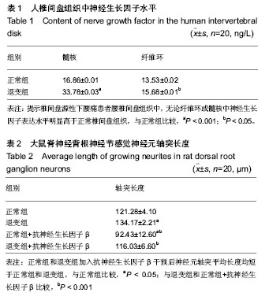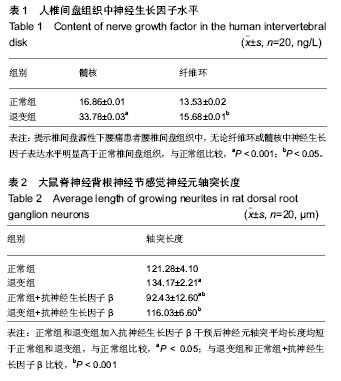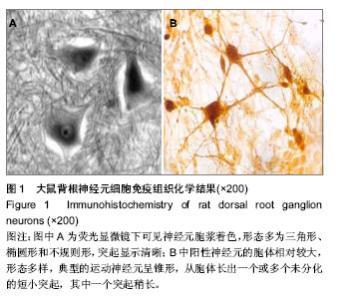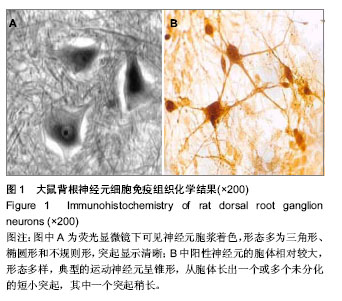Chinese Journal of Tissue Engineering Research ›› 2014, Vol. 18 ›› Issue (7): 1039-1044.doi: 10.3969/j.issn.2095-4344.2014.07.010
Previous Articles Next Articles
Extracelluar matrix stimulates neurite outgrowth of dorsal root ganglion neurons differently depending on whether extracted from degenerated or normal intervertebral disk
Zhang Hui1, Liu Lin2, Xue Wen2
- 1Department of Orthopedics, Second People’s Hospital of Gansu Province, Lanzhou 730000, Gansu Province, China
2Department of Orthopedics, People’s Hospital of Gansu Province, Lanzhou 730000, Gansu Province, China
-
Revised:2013-12-01Online:2014-02-12Published:2014-02-12 -
Contact:Liu Lin, Chief physician, Department of Orthopaedics, People’s Hospital of Gansu Province, Lanzhou 730000, Gansu Province, China -
About author:Zhang Hui, Master, Attending physician, Department of Orthopaedics, Second People’s Hospital of Gansu Province, Lanzhou 730000, Gansu Province, China -
Supported by:the Natural Science Foundation of Gansu Province, No. 2010GS04988
CLC Number:
Cite this article
Zhang Hui, Liu Lin, Xue Wen. Extracelluar matrix stimulates neurite outgrowth of dorsal root ganglion neurons differently depending on whether extracted from degenerated or normal intervertebral disk[J]. Chinese Journal of Tissue Engineering Research, 2014, 18(7): 1039-1044.
share this article

2.2 人椎间盘组织神经生长因子浓度测定结果 正常人腰椎间盘髓核中神经生长因子浓度为(16.86±0.01) ng/L,与退变组(33.78±0.03) ng/L 相比较,差异有非常显著性意义(P < 0.001)。而正常纤维环组织为(13.53±0.02) ng/L,与退变组(15.68±0.01) ng/L比较,差异有显著性意义 (P < 0.05),见表1。提示在椎间盘源性下腰痛患者腰椎间盘组织中,无论纤维环或髓核中神经生长因子表达水平明显高于正常椎间盘组织。 2.3 大鼠脊神经背根神经节感觉神经元轴突生长测定结果 见表2。退变组神经元轴突平均长度显著长于正常组 (P < 0.05)。退变组加抗神经生长因子β干预后神经元轴突平均长度显著长于正常组加抗神经生长因子β干预后神经元轴突平均长度(P < 0.001)。 2.4 大鼠脊神经背根神经节感觉神经细胞P物质水平测定结果 在正常组的257个细胞中Ellsa染色阳性者59个(约22.9%),在退变组的305个细胞中Ellsa染色阳性者约175个(约57.4%),在正常组加抗神经生长因子β干预的98个细胞中Ellsa染色阳性者约44个(约44.9%),在退变组加抗神经生长因子β干预的213个细胞中Ellsa染色阳性者约35个(约16.4%)。由此可以看出,在退变人椎间盘组织培养液中P物质比率明显高于正常组(P < 0.001),差异有非常显著性意义。"

| [1] Crock HV. Internal disc disruption: A challenge to disc prolapse fifty years on.Spine.l986;1(6):650-653.[2] Milette PC,Melanson D.Lumbar fiscography (letter).Radiology. 1987;163(19): 828-829.[3] Freemont AJ,Peacock TE,Goupille P, et al.Nerve ingrowth into diseased intervertebral disc in chronic back Pain.Lancet. 1997;350(9072):178-181.[4] 于一凡,谭晓琳,孙晋民.神经生长因子与周围神经病变相关性研究进展[J].中国现代医药杂志,2009,11(11):128-129.[5] 郭向飞,倪家骧.神经生长因子在椎间盘源性疼痛中的作用机制研究进展[J].颈腰痛杂志,2010,31(6):457-459.[6] 陈世新,丁茂超,胡斯旺,等.内源性神经生长因子在大鼠炎性痛中的作用及其机制[J].温州医学院学报,2011,41(2):129-131.[7] Pande KC, Khurjekar K, Kanikdaley V. Correlation of low backpain to a high-intensity zone of the lumbar disc in Indian patients. Orthop Surg (Hong Kong).2009;17(2):190-193.[8] 韩松,姜宏. 椎间盘源性下腰痛的研究进展[J].中国中医骨伤科杂志,2011,19(5):69-70.[9] Thompson KJ, Dagher AP, Eckel TS, et al. Modic changes on MR images as studied with provocative diskography: clinical relevance- a retrospective study of 2457 disks. Radiology. 2009;250(3):849-855.[10] Wasan AD, Kaptchuk TJ, Davar G, et al. The association between psychopathology and placebo analgesia in patients with discogenic low back pain. Pain Med.2006;7(3):217-228.[11] Carragee EJ, Alamin TF, Miller JL, et al. Discographic, MRI and psychosocial determinants of low back pain disability and remission:a prospective study in subjects with benign persistent back pain. Spine J.2005;5(1):24-35.[12] 郭团茂,陈忠宁,王忠贵.椎间盘源性下腰痛的组织病理学变化[J].中国组织工程研究与临床康复,2011,15(39):7366-7370[13] Gonlnoue G,Ohtori S,Aoki Y.Exposure of the nucleus pulposus to the outside of the anulus fibrosus induces nerve injury and regeneration of the afferent fibers innervating the lumbar intervertebral discs in rats.Spine.2006;31(13):1433- 1438.[14] Herkowitz HN,Gaffin SR,Balderston RA,et al.Roth man Sime on the spine.4th ed.Beijing:Science Press.2001:750.[15] 王日成.椎间盘源性下腰痛研究进展[J].中国现代医药杂志,2010,12(6):121-122.[16] 唐福兴,梁博伟,李宁宁,等.椎间盘退变程度与盘源性腰痛手术疗效的关系[J].广东医学,2013,34(7):1084-1086. [17] 王永刚,王栓科,周海宇.椎间盘源性腰痛的相关基础研究进展[J]. 现代生物医学进展,2012,12(30):5974-5977.[18] 王刚,陈志维,关宏刚,等.应用椎间盘造影判断腰椎间盘突出症腰痛的来源[J].中国矫形外科杂志,2011,19(1):15-19. [19] 李杨,杜勇,杨汉丰,等. MRI对腰椎间盘源性疼痛的诊断价值研究[J].医学影像学杂志,2011,21(1):103-106. [20] 江正,尹宗生.椎间盘源性腰痛的病理生理学机制及组织工程学技术[J].中国组织工程研究与临床康复,2010,14(20): 3736- 3739.[21] 袁慧书,庞超楠,刘晓光,等. CT引导下椎间盘造影对椎间盘源性腰痛的诊断价值[J].中国脊柱脊髓杂志,2009,19(6):412-415. [22] 李兵.椎间盘造影在手术治疗盘源性腰痛中的应用[J].微创医学, 2008,3(6):598-600.[23] 邹健,雷刚刚,吴庆能,等.椎间盘源性下腰痛与椎间盘内神经侵润生长的关系[J].实用临床医学,2008,9(6):24-26. [24] 向志军,钟生才.椎间盘源性下腰痛的最新认识[J].亚太传统医药, 2007,3(11):65-68. [25] 卓祥龙,李兵.盘源性腰痛的研究现状[J].广西医学,2007, 29(10): 1553-1555.[26] 陈兴灿,刘乃芳,李晓红,等. CT腰椎间盘造影术对椎间盘源性下腰痛的诊断价值[J].浙江医学,2007,29(7):658-660. [27] 许彪,李绪松,魏琪,等.盘源性腰痛相关问题的探讨[J]. 检验医学与临床,2007,4(5):394-395.[28] 刘林,李鑫鑫.椎间盘源性腰痛的诊断与治疗[J]. 医学综述,2007, 13(12):928-930.[29] 石作为,姚猛,王岩松,等.间盘源性下腰痛发生机制的探讨[J]. 中国疼痛医学杂志,2007,13(1):32-35. [30] 张德仁,熊东林,肖礼祖,等.选择性脊神经根阻滞治疗盘源性坐骨神经痛[J].实用疼痛学杂志,2006,2(4):199-202. [31] 周毅力,宋文阁,刘甬民,等.间盘源性腰痛的诊断与微创治疗[J]. 实用疼痛学杂志,2006,2(1):33-39. [32] 石作为,姚猛,王岩松,等.间盘源性下腰痛发生的神经解剖学基础[J].中国临床康复,2005,9(45):88-89. [33] 邱红明,孙鲁,李静,等.间盘源性下腰痛的诊断与辨证治疗[J].山东中医杂志,2005,24(9):536-537. [34] 王扬生,陈其昕.椎间盘源性下腰痛[J].颈腰痛杂志, 2003,24(5): 536-537. [35] 彭宝淦,侯树勋.交感神经在腰椎间盘的分布和盘源性下腰痛的神经传导通路[J].颈腰痛杂志,2001,22(3):247-248. [36] 彭宝淦,王拥军.国外对盘源性腰痛炎症机理的研究进展[J].中医正骨,1998,10(3):37-38.[37] 雷刚刚,吴庆能.椎间盘源性下腰痛与椎间盘内神经侵润生长的关系[J].实用临床医学, 2008, 9(6):24-25. [38] 张一鸣,张沂,唐萌芽.补肾活血中药薰蒸治疗盘源性下腰痛疗效观察[J].中医正骨,2013,25(5): 35-36. [39] 邹聪,何云武,陈金生,等. X线引导下双极射频热凝治疗盘源性腰痛32例[J].中南医学科学杂志,2013,41(1): 31-34. [40] 黄雷,李军汉.电针、推拿结合牵引治疗盘源性下腰痛疗效观察[J].颈腰痛杂志,2011,32(3): 237-238. [41] 黄乔东,魏迨桂,赵国栋,等.椎间盘内电热疗法治疗盘源性腰痛临床观察[J]. 南方医科大学学报,2010,30(10): 2406-2407,2410. [42] 王明政,李汝秀,郑瑞启.臭氧在椎间盘源性腰痛诊治中的应用[J]. 骨科,2010,1(2): 95-96 [43] 陈立,张秀玲,兰秀芳.推拿配合躯干肌功能锻炼治疗慢性盘源性腰痛的临床分析[J].中医正骨,2011,23(3): 9-12. [44] 张强,刘萍.水冷式双极射频纤维环成形术联合祛痹止痛膏治疗盘源性腰痛临床研究[J].工企医刊,2011,24(2): 64-66. [45] 闫京奎,刘智鹏,赵家瑜,等.射频消融微创治疗椎间盘源性下腰痛的疗效观察[J].实用骨科杂志,2010,16(9): 680-681. [46] 魏迨桂,黄乔东,赵国栋,等.两种微创治疗方法在盘源性腰痛治疗中的应用[J].临床医学工程,2010,17(10): 8-10.[47] 黄家俊,罗华.神经生长因子促进中枢神经系统损伤后神经再生的作用机制[J].医学综述, 2008,14(3):330-331.[48] Thompson KJ, Dagher AP, Eckel TS, et al. Modic changes on MR images as studied with provocative diskography: clinical relevancea retrospective study of 2457 disks. Radiology. 2009;250(3):849-855.[49] Al-Shawi R, Hafner A, Olsen J, et al.Neurotoxic and neurotrophic roles of proNGF and the receptor sortilin in the adult and ageing nervous system.Eur Neurosci. 2008;27: 2103-2114.[50] Aoki Y,Takahashi Y,Ohtori S. Distribution and immunocyto chemical charac- terization of dorsal root ganglion neurons innervating the lumbar interwerte-bral disc in rats:a review. Life Sci.2004;74(21):2627-2642.[51] Ribatti D, Nico B, Perra MT, et al.Correlation between NGF TrkA and microvascular density in human Pterygium. Int J Exp Pathol. 2009;90(6):615-620.[52] Peters EM, Raap U, Welker P, et al. Neurotrophins act as neuroendocrine regulators of skin homeostasis in health and disease.Horm Metab Res.2007;39(2):110-124.[53] Sugiura A, Ohtori S, Yamashita M, et al. Existence of nerve growth factor receptors, tyrosine kinase a and p75 neurotrophin receptors in intervertebral discs and on dorsal root ganglion neurons innervating intervertebral discs in rats. Spine.2008;33(19):2047- 2051.[54] Garcia M, Forster V, Hicks D, et al. In vivo expression of neurotrophins and neurotrophin receptors is conserved in adult porcine retina in vitro. Invest Ophthalmol Vis Sci.2003; 44(10):4532[55] Pande KC, Khurjekar K, Kanikdaley V. Correlation of low back pain to a highintensity zone of the lumbar disc in Indian patients. Orthop Surg (Hong Kong).2009;17(2):190-193. [56] 王丽华,姜虹.不同剂量神经生长因子对神经源性疼痛大鼠脊髓 Fos蛋白的影响[J].中国组织工程研究与临床康复, 2009, 13(50): 9866-9869.[57] 王德胜,黄烈天,扬兴桃.鼠神经生长因子(mNGF)局部注射治疗周围神经缺损伤的临床研究[J].齐齐哈尔医学院学报, 2011, 32(3):369[58] 彭形.神经生长因子生物学效应的研究进展[J].检验医学与临床, 2009,6(3):203-204.[59] 路露,陈美婉,罗焕敏.神经营养因子受体的研究进展[J].中国老年医学杂志,2010,30:126-131. [60] Ashton IK, Roberts S, Jaffray DC, et al. Neuropeptides in the human intervertebral disc. J Orthop Res.1994;12(2):186-192.[61] Peng B, Wlu W, Hou S, et al.The Pathogenesis of Discogenic Low Back Pain.J Bone Joint Surg Br.2005; 87(1):62-67.[62] Aoki Y,Ohtori S,Takahashi K, et al. In nervation of the lumbar intervertebral disc by nerve growth factor dependent neurons related to inflammatory pain. Spine.2004; 29(10):1077-1081.[63] Yamaguchi J, Aihara M, Kobayashi Y, et al. Quantitative analysis of nerve growth factor (NGF) in the atopic dermatitis and psoriasis horny layer and effect of treatment on NGF in atopic dermatitis . J Dermatol Sci. 2009,53:48-54.[64] Purmessur D,Freemont AJ,Hoyland JA. Expression and regulation of neurotrophins in the nondegenerate and degenerate human interverteb-ral disc.Arthritis Res Ther. 2008; 10(4):99-100.[65] Richardson SM,Doyle P,Minogue BM, et al.Increased expression of matrix metalloproteinase-10,nerve growth factor and substance P in the painful degenerate intervertebral disc.Arthritis Rea Ther.2009; 11(4):126-127.[66] 周昊嵬,侯树勋,商卫林.椎间盘源性下腰痛与椎间盘内神经生长[J].国外医学:骨科学分册,2011,26(6):339-341.[67] Lee S,Moon CS,Sul D, et al. Comparison of growth factor and cytokine expression in patients with degenerated disc disease and herniated nucleus pulposus.Clin Biochem.2009; 42(15): 1504-1511.[68] Lei D, Rege A, Koti M, et al. Painful disc lesion: can modern biplanar magnetic resonance imaging replace discography. Spinal Disord Tech. 2008,21(6):430-435.[69] 何传正,唐海燕,吴发庆.椎间盘源性下腰痛的发生机制与治疗现状[J].吉林医学,2010,31(18):2909-2910. |
| [1] | Luo Xuanxiang, Jing Li, Pan Bin, Feng Hu. Effect of mecobalamine combined with mouse nerve growth factor on nerve function recovery after cervical spondylotic myelopathy surgery [J]. Chinese Journal of Tissue Engineering Research, 2021, 25(5): 719-722. |
| [2] | Xie Yang, Lü Zhiyu, Zhang Shujiang, Long Ting, Li Zuoxiao. Effects of recombinant adeno-associated virus mediated nerve growth factor gene transfection on oligodendrocyte apoptosis and myelination in experimental autoimmune encephalomyelitis mice [J]. Chinese Journal of Tissue Engineering Research, 2021, 25(23): 3678-3683. |
| [3] | Yan Nan, Si Xiaofeng, Zeng Liang, Tian Wei, Shan Guangdong, Xiong Lishuo, Yang Weijie, Wang Zhengdong. Nerve growth factor interferes with proliferation and alpha-actin expression of skeletal muscle satellite cells in rats [J]. Chinese Journal of Tissue Engineering Research, 2021, 25(13): 2030-2035. |
| [4] | Liu Guoming, Wang Qinfen, Lin Kefeng, Zhou Shiguo, Chen Zuxing, Lin Shishui. Whole body application of nerve growth factor promotes early healing of tibial shaft fracture and improves expression of bone morphogenetic protein-2 and vascular endothelial growth factor in rats [J]. Chinese Journal of Tissue Engineering Research, 2020, 24(29): 4680-4685. |
| [5] |
Wang Ning, Chen Junyi, Zhu Lunjing, Duan Jiangtao, Wang Ye, Li Zhijun, Bei Chaoyong.
Lentivirus-mediated P75 neurotrophin receptor silencing combined with nerve growth factor overexpression promotes proliferation of rat bone marrow mesenchymal stem cells [J]. Chinese Journal of Tissue Engineering Research, 2020, 24(25): 3988-3993. |
| [6] | Shu Gao, Chen Xiaodong, Zhai Mingyu, Li Quanxiu, Liang Pengzhan, Yang Xuejun, Zhao Haibo, Yu Chenqiang, Bai Xueling, Li Long. Imaging evaluation and biomechanical characteristics of the novel intradiscal electrothermal annuloplasty in pigs [J]. Chinese Journal of Tissue Engineering Research, 2019, 23(8): 1214-1221. |
| [7] |
Wen Yi, Su Feng, Liu Su, Zong Zhiguo, Zhang Xin, Ma Pengpeng, Li Yuexuan, Li Rui, Zhang Zhimin.
Establishment of finite element model of L4-5 and mechanical analysis of degenerative intervertebral discs
|
| [8] | Wang Tong, Liu Yang, Zhu Yetao. Combined use of exogenous nerve growth factor and basic fibroblast growth factor promotes proliferation of endogenous brain cells in a rat model of severe traumatic brain injury [J]. Chinese Journal of Tissue Engineering Research, 2019, 23(25): 3998-4003. |
| [9] | Zhu Lunjing, Bei Chaoyong, Duan Jiangtao, Peng Chengfei, Ma Yuegang, Wang Ning, Chen Junyi . Liposome- versus lentivirus-mediated transfection of P75 nerve growth factor receptor and nerve growth factor into bone marrow mesenchymal stem cells [J]. Chinese Journal of Tissue Engineering Research, 2019, 23(21): 3302-3308. |
| [10] | Li Pengfei, Wang Tao, Ma Xinlong . Association between COL9A2 gene polymorphisms and intervertebral disc degeneration in Asian: a meta-analysis [J]. Chinese Journal of Tissue Engineering Research, 2019, 23(20): 3275-3280. |
| [11] | Gao Ming-long, Shi Shao-xia, Zhang Kun, Zhang Ying-dong, Li Na, Yu Ming, Wang Yong-liang. Effects of brain-derived neurotrophic factor-modified human amniotic membrane-derived mesenchymal stem cell transplantation on learning and memory abilities of Alzheimer's disease rats [J]. Chinese Journal of Tissue Engineering Research, 2018, 22(9): 1419-1424. |
| [12] | Tian Yi-xing, Bao Zhao-hua, Zou Jun, Ji Yi-ming, Mei Xin, Pan Jun, He Wen-ye, Yang Hui-lin. Short-term effectiveness of single-level Isobar TTL dynamic internal fixation in the treatment of lumbar degenerative diseases [J]. Chinese Journal of Tissue Engineering Research, 2018, 22(7): 1020-1025. |
| [13] | Feng Xian-xuan, Xu Yi-ming, Cai Yun, Bai Yue-hong . Non-surgical spinal decompression system versus conventional traction device for treating lumbar disc herniation through surface electromyography [J]. Chinese Journal of Tissue Engineering Research, 2018, 22(7): 1032-1037. |
| [14] | Zhang Lei, Zhou Song, Cheng Bao-chang. Actuality and challenge of biomaterials in annulus fibrosus repair [J]. Chinese Journal of Tissue Engineering Research, 2018, 22(6): 958-963. |
| [15] | Yang Xiao-ming, Zhao Quan-lai, Gao Zhi, Xu Hong-guang, Wang Hong, Liu Ping. Expression and significance of Wnt-5a gene in a model of intervertebral disc degeneration [J]. Chinese Journal of Tissue Engineering Research, 2018, 22(4): 570-575. |
| Viewed | ||||||
|
Full text |
|
|||||
|
Abstract |
|
|||||

